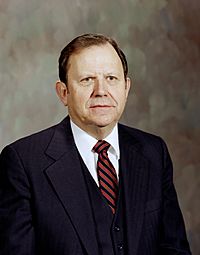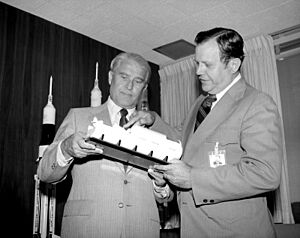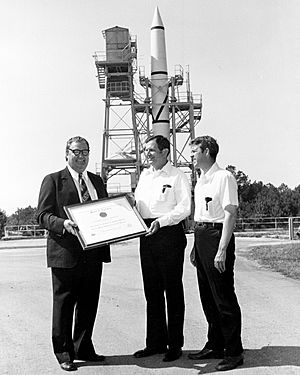William R. Lucas facts for kids
Quick facts for kids
William R. Lucas
|
|
|---|---|

Official NASA portrait of Dr. William R. Lucas
|
|
| Born |
William Ray Lucas
March 1, 1922 Newbern, Tennessee, U.S.
|
| Died | February 10, 2025 (aged 102) Huntsville, Alabama, U.S.
|
| Education | Memphis State College Vanderbilt University |
| Occupation | NASA administrator |
| Title | Director of the Marshall Space Flight Center |
William Ray Lucas (March 1, 1922 – February 10, 2025) was an important leader at NASA. He was the fourth Director of the Marshall Space Flight Center. He led the center from June 15, 1974, until July 3, 1986.
Contents
Early Life and Space Career
William Ray Lucas was born in Newbern, Tennessee, on March 1, 1922. He studied chemistry at Memphis State College (now the University of Memphis). He graduated in 1943. Later, he earned two more degrees in metallurgy from Vanderbilt University in Nashville. Metallurgy is the study of how metals behave. He also served in the United States Navy during World War II.
Joining the Space Team
In 1952, Lucas moved to Huntsville, Alabama. There, he joined Wernher von Braun's team. This team worked on rockets at the Army Ballistic Missile Agency. By 1956, he became the agency's materials officer. In this role, he helped design the system that controlled the temperature for Explorer 1. This was the first American satellite in space. He also chose the materials for the rocket that carried Alan Shepard. Shepard became the first American in space in 1961.
Working at NASA Marshall
In 1960, von Braun's team became part of NASA. It was named the Marshall Space Flight Center. Lucas moved to this new organization. He worked in the Propulsion and Vehicle Engineering Laboratory. He eventually became its director. While there, he helped create the powerful engine system for the Saturn V rocket. This rocket took astronauts to the Moon. He also helped develop Skylab, which was the second space station ever built.
Leading the Marshall Space Flight Center
After working as Marshall's deputy director for three years, Lucas became the center's director in 1974. He took over just two years after the Space Shuttle program began. Under his leadership, Marshall was in charge of the Space Shuttle's propulsion system. This included the large solid rocket boosters (SRBs) and the main engines on the Orbiter.

Management Style
As director, Lucas was known for being very strict. He expected things to be done precisely. He wanted to see clear facts and numbers in all decisions. He also had a rule that Marshall Center should never cause a delay in a space shuttle launch.
Challenger Disaster and Retirement
William Lucas received many honors from NASA for his work. However, he became widely known after the Space Shuttle Challenger disaster in 1986. After the accident, it was found that some people at Marshall, including Lucas, knew about a possible problem with the solid rocket boosters. This problem involved the "field joints" on the boosters. These joints were supposed to seal tightly when the rocket fired. But instead, the metal parts could bend away from each other. This could create a gap where hot gases might leak out and damage the O-ring seals. If the O-rings failed, the booster could break apart, destroying the shuttle.
Because of the rule about not delaying launches, Marshall managers did not report how serious the O-ring problem was. They kept the issue within their own teams and with the contractor, Thiokol. Even when the O-rings were labeled "Criticality 1" (meaning their failure would destroy the Orbiter), no one at Marshall suggested stopping flights until the problem was fixed. Senior NASA leaders did not fully understand the problem until an auditor found a contract for a redesigned booster in 1985.
After the Challenger accident, a letter was sent to the center's inspector general. This letter described Lucas's management style. The letter reached the Rogers Commission, which investigated the accident. Following strong criticism from the commission, Lucas retired in July 1986.
Later Life and Passing
William Lucas passed away at his home in Huntsville, Alabama, on February 10, 2025. He was 102 years old.
Awards and Recognition
- In 1978, Lucas became a member of the National Academy of Engineering. This was for his work in designing space vehicles and solving problems in space flight.
- In 1984, the University of Memphis gave him a Distinguished Alumni Award. This award recognizes former students who have achieved great things and contributed to society.
- In 1986, Lucas received the Elmer A. Sperry Award. This award honors important engineering contributions that improve transportation. He shared this award with others for their work on the reusable Space Transportation System, which was the Space Shuttle.


